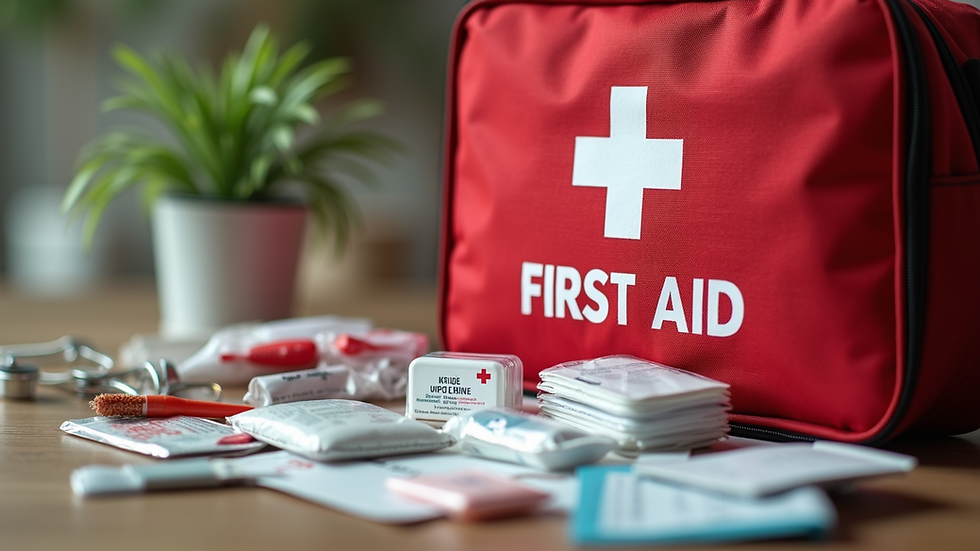First Aid Essentials for Outdoor and Remote Locations
- Aryeh Goldberg

- Sep 29
- 4 min read
When venturing into the great outdoors or remote locations, being prepared for emergencies is crucial. Whether you are hiking, camping, or working in forestry, having the right first aid knowledge and supplies can make a significant difference. This guide will walk you through the essential first aid items and skills needed to handle common injuries and emergencies in outdoor settings. It will also highlight the importance of specialised forestry aid to ensure safety in woodland environments.
Why Forestry Aid is Important in Remote Areas
Forestry aid is a specialised form of first aid tailored to the unique risks and challenges found in forested and remote areas. These environments often have limited access to medical facilities, uneven terrain, and exposure to wildlife and harsh weather. This means that injuries can be more severe and help may take longer to arrive.
Having a well-stocked first aid kit and knowing how to use it can help you manage injuries such as cuts, sprains, insect bites, and burns until professional help is available. It also boosts confidence and safety for anyone spending time in the wilderness.
Key reasons to prioritise forestry aid include:
Delayed emergency response times due to remote locations
Increased risk of injuries from tools, equipment, and natural hazards
Exposure to environmental factors like cold, heat, and insects
Need for self-reliance when medical help is not immediately accessible

Essential First Aid Supplies for Outdoor and Remote Locations
Packing the right first aid kit is the first step in being prepared. Your kit should be compact but comprehensive enough to handle common injuries and emergencies. Here is a list of must-have items for any outdoor first aid kit:
Sterile dressings and adhesive bandages in various sizes for cuts and scrapes
Antiseptic wipes and creams to clean wounds and prevent infection
Elastic bandages for sprains and strains
Tweezers for removing splinters or ticks
Scissors for cutting tape or clothing
Pain relief medication such as paracetamol or ibuprofen
Burn cream or gel for minor burns
Disposable gloves to maintain hygiene
CPR face shield for safe resuscitation
Emergency blanket to prevent hypothermia
Insect repellent and sting relief for bites and stings
Splint materials for immobilising broken bones or severe sprains
It is also wise to include any personal medications and a first aid manual or quick reference guide. Regularly check and replenish your kit to ensure all items are in date and usable.

What is forestry first aid?
Forestry first aid is a specialised training and approach designed to address the specific injuries and emergencies that occur in forestry and woodland environments. It covers not only basic first aid skills but also how to manage incidents involving chainsaws, heavy machinery, and falls from height.
This type of first aid training emphasises rapid assessment, effective wound management, and safe evacuation techniques in challenging terrain. It also includes knowledge about environmental hazards such as poisonous plants, animal bites, and extreme weather conditions.
For those working or spending significant time in forests, completing a forestry first aid course can be invaluable. It equips individuals with the confidence and skills to respond effectively to emergencies until professional medical help arrives.

Practical Tips for Administering First Aid Outdoors
Administering first aid in remote locations requires calmness, clear thinking, and adaptability. Here are some practical tips to help you provide effective care:
Assess the scene for safety before approaching the injured person. Look out for hazards like falling branches or unstable ground.
Wear gloves to protect yourself and the casualty from infection.
Stop any bleeding by applying direct pressure with a clean dressing. Elevate the injured limb if possible.
Clean wounds gently with antiseptic wipes to reduce infection risk. Avoid using dirty water or unsterile materials.
Immobilise fractures or sprains using splints or elastic bandages to prevent further injury.
Treat for shock by keeping the person warm and comfortable. Use an emergency blanket if available.
Monitor vital signs such as breathing and consciousness regularly. Be prepared to perform CPR if necessary.
Keep the casualty hydrated but avoid giving food or drink if they are unconscious or vomiting.
Plan for evacuation by contacting emergency services or arranging transport if the injury is serious.
10. Stay calm and reassure the injured person to reduce anxiety and panic.
Remember, your goal is to stabilise the casualty and prevent the condition from worsening until professional help arrives.
Preparing Yourself and Others for Outdoor Emergencies
Preparation is key to staying safe in outdoor and remote locations. Beyond packing a first aid kit, consider these steps:
Take a first aid course that covers outdoor and wilderness scenarios. This builds confidence and practical skills.
Learn how to use your first aid kit before you need it. Practice bandaging and splinting techniques.
Inform someone of your plans and expected return time when heading into remote areas.
Carry a reliable communication device such as a satellite phone or personal locator beacon.
Dress appropriately for the environment and weather conditions to prevent hypothermia or heatstroke.
Stay aware of your surroundings and avoid unnecessary risks.
Know the location of the nearest medical facility and emergency contact numbers.
By preparing yourself and your group, you can reduce the likelihood of accidents and improve outcomes if injuries occur.
Being equipped with the right knowledge and supplies for first aid in outdoor and remote locations is essential. Whether you are a forestry worker, outdoor enthusiast, or adventurer, understanding the basics of forestry aid and having a well-stocked kit can save lives. Take the time to prepare, learn, and stay safe on your next outdoor journey.





Comments